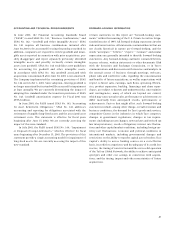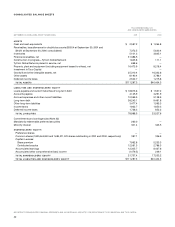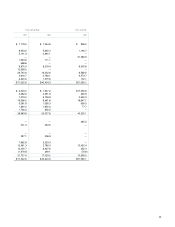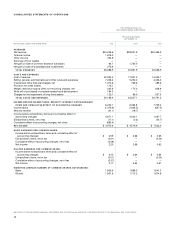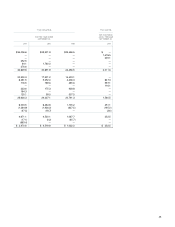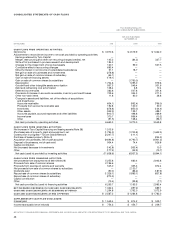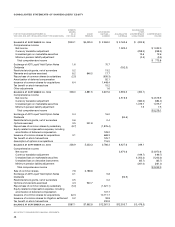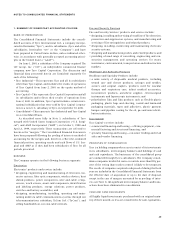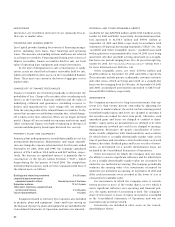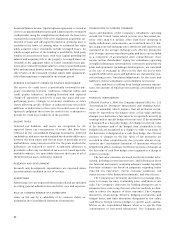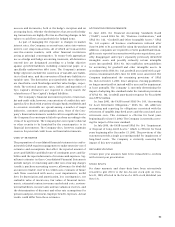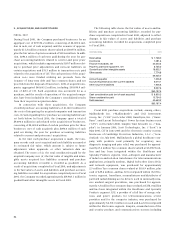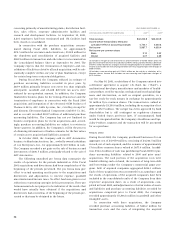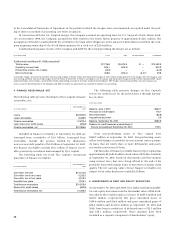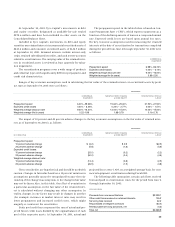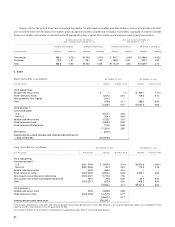ADT 2001 Annual Report Download - page 52
Download and view the complete annual report
Please find page 52 of the 2001 ADT annual report below. You can navigate through the pages in the report by either clicking on the pages listed below, or by using the keyword search tool below to find specific information within the annual report.
50
INVENTORIES
Inventories are recorded at the lower of cost (primarily first-in,
first-out) or market value.
FINANCING AND LEASING ASSETS
Tyco Capital provides funding for a variety of financing arrange-
ments, including term loans, lease financing and operating
leases. The amounts outstanding on loans and leases are referred
to as finance receivables. Financing and leasing assets consist of
finance receivables, finance receivables held for sale, net book
value of operating lease equipment and certain investments.
At the time of designation for sale, securitization or syndi-
cation, assets are classified as finance receivables held for sale,
which are included in other assets on the Consolidated Balance
Sheet. These assets are carried at the lower of aggregate cost or
market value.
CHARGE-OFF OF FINANCE RECEIVABLES
Finance receivables are reviewed periodically to determine the
probability of loss. Charge-offs are taken after considering such
factors as the borrower’s financial condition and the value of
underlying collateral and guarantees (including recourse to
dealers and manufacturers). Such charge-offs are deducted
from the carrying value of the related finance receivables. To the
extent that an unrecovered balance remains due, a final charge-
off is taken at the time collection efforts are no longer deemed
useful. Charge-offs are recorded on consumer and certain small
ticket commercial finance receivables beginning at 180 days of
contractual delinquency based upon historical loss severity.
PROPERTY, PLANT AND EQUIPMENT
Property, plant and equipment is recorded principally at cost less
accumulated depreciation. Maintenance and repair expendi-
tures are charged to expense when incurred. For the years ended
September 30, 2001, 2000 and 1999, the Company capitalized
interest of $76.3 million, $10.8 million and $8.7 million, respec-
tively. The increase in capitalized interest is primarily due to
construction of the TyCom Global Network (“TGN”), which
began during the last quarter of Fiscal 2000. The straight-line
method of depreciation is used over the estimated useful lives of
the related assets as follows:
Buildings and related improvements 5 to 50 years
Leasehold improvements and
equipment leased to others Remaining term of the lease
Subscriber systems 10 to 14 years
Other plant, machinery, equipment and
furniture and fixtures 2to 25 years
TyCom Global Network 15 years
Equipment leased to others by Tyco Capital is also included
in property, plant and equipment. Gains and losses arising on
the disposal of property, plant and equipment are included in the
Consolidated Statements of Operations and were not material.
GOODWILL AND OTHER INTANGIBLE ASSETS
Goodwill, net was $29,790.8 million and $13,723.0 million at Sep-
tember 30, 2001 and 2000, respectively. Accumulated amortiza-
tion amounted to $1,556.5 million and $959.3 million at
September 30, 2001 and 2000, respectively. In accordance with
Statement of Financial Accounting Standards (“SFAS”) No. 142,
“Goodwill and Other Intangible Assets,” goodwill associated
with acquisitions consummated after June 30, 2001 is not being
amortized. All other goodwill is being amortized on a straight-
line basis over periods ranging from 10 to 40 years through Sep-
tember 30, 2001. See “Accounting Pronouncements” within Note 1
for more information on SFAS No. 142.
Other intangible assets, net were $5,519.6 million and
$2,609.6 million at September 30, 2001 and 2000, respectively.
These amounts include patents, trademarks, customer contracts
and other items, which are being amortized on a straight-line
basis over lives ranging from 2 to 40 years. At September 30, 2001
and 2000, accumulated amortization amounted to $885.3 mil-
lion and $525.2 million, respectively.
INVESTMENTS
The Company accounts for its long-term investments that rep-
resent less than twenty percent ownership by adjusting the
securities to market value at the end of each accounting period.
Unrealized market gains and losses are charged to earnings if
the securities are traded for short-term profit. Otherwise, such
unrealized gains and losses are charged or credited to share-
holders’ equity unless an unrealized loss is deemed to be other
than temporary, in which case such loss is charged to earnings.
Management determines the proper classification of invest-
ments in debt obligations with fixed maturities and securities
for which there is a readily determinable market value at the
time of purchase and reevaluates such classifications as of each
balance sheet date. Realized gains and losses on sales of invest-
ments, as determined on a specific identification basis, are
included in the Consolidated Statements of Operations.
Other investments for which the Company does not have
the ability to exercise significant influence and for which there
is not a readily determinable market value are accounted for
under the cost method of accounting. The Company periodically
evaluates the carrying value of its investments accounted for
under the cost method of accounting. At September 30, 2001 and
2000, such investments were recorded at the lower of cost or
estimated net realizable value.
For investments in which the Company owns or controls
twenty percent or more of the voting shares, or over which it
exerts significant influence over operating and financial poli-
cies, the equity method of accounting is used. The Company’s
share of net income or losses of equity investments is included
in the Consolidated Statements of Operations and was not
material in any period presented.
Investments are included in other assets on the Consoli-
dated Balance Sheets.



